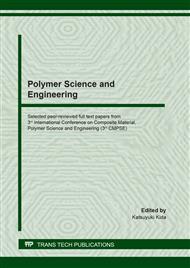[1]
P.S. Ambily, Development of ultra-high- performance geopolymer concrete, Mag. Concr. Res. 66 (2014) 82–89.
Google Scholar
[2]
J. Davidovits, D.C. Comrie, J.H. Paterson, D.J. Ritcey, Geopolymeric concretes For Environmental Protection, Concr. Int. 12 (1990) 30–40.
Google Scholar
[3]
J. Davidovits, Geopolymer Chemistry and Applications, (2015).
Google Scholar
[4]
W. Ren, J. Xu, J. Liu, H. Su, Dynamic mechanical properties of geopolymer concrete after water immersion, Ceram. Int. 41 (2015) 11852–11860.
DOI: 10.1016/j.ceramint.2015.05.154
Google Scholar
[5]
J. Davidovits, Chemistry of Geopolymeric Systems, Terminology, Geopolymer '99 Int. Conf. Technol. Compiegne, Fr. (1999) 9–40.
Google Scholar
[6]
A. Palomo, M.W. Grutzeck, M.T. Blanco, Alkali-activated fly ashes: A cement for the future, Cem. Concr. Res. 29 (1999) 1323–1329.
DOI: 10.1016/s0008-8846(98)00243-9
Google Scholar
[7]
V.F.. Barbosa, K.J.. MacKenzie, C. Thaumaturgo, Synthesis and characterisation of materials based on inorganic polymers of alumina and silica: sodium polysialate polymers, Int. J. Inorg. Mater. 2 (2000) 309–317.
DOI: 10.1016/s1466-6049(00)00041-6
Google Scholar
[8]
H. Xu, J.S.J. Van Deventer, The geopolymerisation of alumino-silicate minerals, Int. J. Miner. Process. 59 (2000) 247–266.
DOI: 10.1016/s0301-7516(99)00074-5
Google Scholar
[9]
H. Yan, V. Kodur, B. Wu, J. Yan, Z. Sheng, Effect of temperature on bond characteristics of geopolymer concrete, 163 (2018) 277–285.
DOI: 10.1016/j.conbuildmat.2017.12.043
Google Scholar
[10]
G. Mathew, B. Joseph, Flexural behaviour of geopolymer concrete beams exposed to elevated temperatures, J. Build. Eng. 15 (2018) 311–317.
DOI: 10.1016/j.jobe.2017.09.009
Google Scholar
[11]
P.K. Sarker, S. Mcbeath, I. Tech, Fire endurance of steel reinforced fly ash geopolymer concrete elements, Constr. Build. Mater. 90 (2015) 91–98.
DOI: 10.1016/j.conbuildmat.2015.04.054
Google Scholar
[12]
Astm, Standard Specification for Coal Fly Ash and Raw or Calcined Natural Pozzolan for Use, Annu. B. ASTM Stand. (2010) 3–6.
DOI: 10.1520/c0618-12a
Google Scholar
[13]
ASTM C494, Standard Specification for Chemical Admixtures for Concrete, ASTM Int. (2013) 1–9.
Google Scholar
[14]
ASTM C109/C109M, Standard Test Method for Compressive Strength of Hydraulic Cement Mortars ( Using 2-in . or [ 50-mm ] Cube Specimens ) 1, ASTM Int. (2016) 1–9.
DOI: 10.1520/c0109_c0109m-13
Google Scholar
[15]
ASTM C496, Standard Test Method for Splitting Tensile Strength of Cylindrical Concrete Specimens, ASTM Int. i (2011) 5.
Google Scholar
[16]
ASTM C642-13, Standard Test Method for Density, Absorption, and Voids in Hardened Concrete, ASTM Int. (2013) 4–6.
Google Scholar


